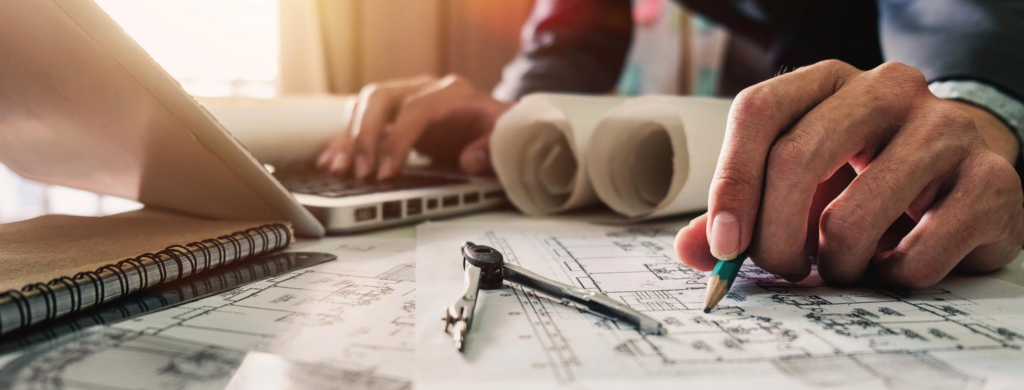How office architecture is adapting for a post-COVID world
This post is part of our series focused on the seismic shift in work systems, traditional office typology, and more. Start at the beginning with an overview.
In this post, we look at the changing role of workplace architects in 2020.
Work is having an existential crisis. What is work? What is a workspace? If everywhere can now feasibly be a workplace, what defines an office? What will office architecture look like a year from now or longer?
Keep reading for different perspectives and emerging strategies.
Office building architecture after COVID-19
Built environments around the world are in flux, and office buildings are at the front of the wave of change.
The novel Coronavirus and its socio-political impact has also added new layers to the work architects undertake when designing a new office building from the ground up.
Say “office of the future” and you think about glossy sci-fi architecture and streamlined tech. In 2020 this couldn’t be further from the truth.
Containment of the virus is a complex process and so regulations change all the time.

This puts architects in a bind when it comes to new office contracts: what features and legislation are needed now?
What measures need to be anticipated?
We would argue that one of the most efficient ways for businesses to survive the pandemic is through agile adaptation to new situations: and that goes for the architecture of their buildings as well.
Organisations that are looking to respond to any pandemic through flexibility, adaptability, and agility may design workplaces that leverage furniture and behavioural solutions to manage social distancing and future occupancy changes. - Returning to the Workplace: Design Considerations (TPG Architecture).
It’s a delicate balancing act between making necessary albeit knee-jerk design decisions in the short term and designing for a (hopefully) Corona-free future.
There are different strands at play here:
- Retrofitting existing offices to fit the demands of the new normal
- Office building projects requiring amendments to plans mid-construction
One thing is certain about office architecture from here on out: its form must, ultimately, enhance its function.
Let’s look at those two strands in detail.
Retrofitting office architecture: flexible design solutions
We’ve seen office interiors being kitted out with protective plexiglass shields, hand sanitising stations and mandatory temperature checks at reception.
This is what we mean when we refer to ‘structural retrofitting’, even on a superficial level.
What’s more interesting from an architectural perspective is how we are populating existing office spaces while respecting the need for social distancing.
“The future success of a healthy workplace will be incumbent on smart planning strategies and behavioural responsibility,” says Suzette Subance Ferrier, managing executive and studio creative director of New York-based TPG Architecture. “Right now, we aren’t seeing a complete shift to cubicles. What we are seeing is a de-densification of the workplace.” (source)
Related post: Coliving is the new face of coworking
New office design considerations for a new world
Some stakeholders in the construction of new office workspaces have begun asking their designers and architects to revamp plans in accommodation of social distancing needs.
They still hope that collaborative work can be made possible in a physical workplace environment.
This forward-thinking approach is a future-proof measure of sorts, one devised to safeguard employees in any pandemic.
As the road to the end of the Coronavirus is predicted to last arduous years, thinking about the design of public spaces now rather than later is a smart move.
Commercial real estate construction has seen abrupt changes to construction codes.
These are developments architects are grappling with along with requirements for new features and designated spacing to maintain the 6-foot social distance.
Smart planning strategies for healthy workplaces
In a recent whitepaper ‘Increasing winter humidity in buildings to reduce the spread of COVID-19’, the LEO A. DALY architecture and engineering firm explore research on built environments and their humidity levels, with interesting ways to retrofit offices and plan for new builds.
Compelling new research such as from the Annual Review of Virology shows that relative humidity levels of at least 40 per cent can substantially suppress transmission of COVID-19, and especially airborne transmission. - source.
This goes hand in hand with our article a few weeks ago, where we looked at statements by the World Health Organisation recommending an “increased ventilation rate through natural aeration or artificial ventilation, preferably without re-circulation of the air”.
How does wellbeing translate into architecture?
Andrew Reeves, a Canada-based architect, remarked that working from home during the pandemic has taught us all more about what suits us best personally when it comes to working.
“In its simplest form, architecture might just be a series of lines and boxes that come together to create a sculptural object. However, the soul of a space is directly connected to characters of its inhabitants and the natural environment that surrounds it.” – Andrew Reeves Principal Partner and Senior Architect of Linebox
This knowledge informs workers as they begin to trickle back into their offices.
It’s people-first design, and it’s more important than ever. Flexible spaces that can adapt to myriad needs will determine success or failure on a productivity level.
Exciting developments in the world of office building architecture
We hope you’ve enjoyed this post and are as fascinated as we are to see how the workplace will come out of its existential crisis!
Check back to the last post we wrote in this series: COVID-19 shapes the open-plan office of the future
